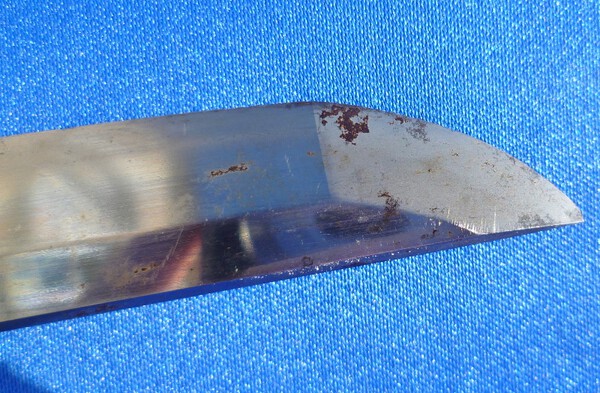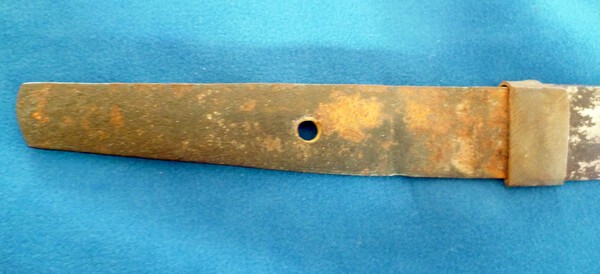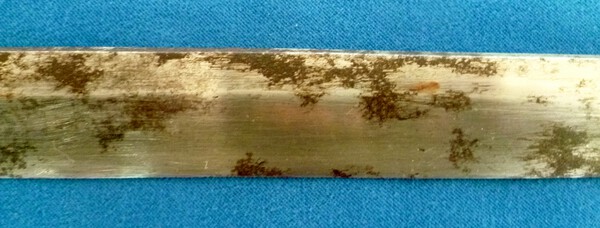
swordeval
Members-
Posts
18 -
Joined
-
Last visited
swordeval's Achievements
-
Hi, I recently acquired a tanto and I was wondering if someone might be able to help me the mei on the nakago (see photos). Would I be incorrect in calling it a unokubi zukuri tanto? I had a go at translating it and I think the second kanji reads Mitsu 光 . Apologies for the poor quality of the photos. Thanks for your help, Ellie,
-
Hi Some weeks back I received some very useful help from the forum on the signature and other aspects of this Wakizashi. At the time I was asked for some better photographs but have only just got around to doing so. I hope they're interesting. Best. Paul
-
Hi again The requested dimensions plus two more images - hopefully to help with tentative date attribution. Total length : 55,6cm Mune: ihori File marks - Kiri Nakago: 13,5cm Kissaki to ha-machi : 42,1cm Width at Mune: 0,5cm Max ha to mune : 2,8cm Max ha to hamon : 0,3cm Ha to shinogi : 2cm Thanks! Paul
-
Hi Stephen/Geraint Very many thanks. I am grateful for your expertise and help. We're still using largely online kanji sources until we get enough 'sense' to think about a good solid reference. Evolutionary growth really! Thanks again. Of yes, I will try and post those dimensions tomorrow and some better shots and dimensions of my other blade too. Cheers. Paul
-
Hi and thanks for your help. Geraint - yes, I will post some dimensions. I should have thought of that. I have compared the signature to one copy of Kuniniro's I have found online and to my still novice eye, they're not quite the same though similar. Yes, I need to remove the red rust colouration and stabilise elements both swords. I do understand the need for extreme caution and conservatism as opposed to taking a wire brush to them! I have limited knowledge of this area but I am much more knowledgeable in horology where many of the same basic principles apply. I have some experience of following best-practice stabilisation on Tsuba's and know how long it can take! Here, I've done a very light, gentle and first-pass red rust rub-off from the signature and attach some revised images. They're not much better frankly but they may help. Very hard to get a clear image until the last of the red rust is removed. Jean - Yes, what I believe is called the Ha (?) contains numerous generally tiny pieces of damage and wear. One is more significant, penetrating almost the depth of the lower part of the Hamon. Pity. Best. Paul
-
-
Hi Here is the second of the two. Unsigned - though some writing on the Tsuba and Saya (images attached). I'll post some additional photos in the response. As always, appreciate any thoughts on age of the blade and translation of the inscriptions. Regards Paul
-
Merci bcp Jean Yes, I will post some better shots. The ones I took yesterday seem to have come out slightly blurred and dark also - I have no idea why that happened as I have a decent camera. Yes, there is a fair degree of orange-red rust. I will follow your tip. Thanks. Paul B.
-
Hi I apologise for failing to sign my post. I admit I just forgot because I normally would do so. I've also never been one to care very much what I'm called - within reason of course! Thanks for that translation Robert S. My daughter and I have done some reading and studying of signatures / Kanji but as I guess the experts here will attest, "easy it aint" for newcomers. Our knowledge, interest and expertise with Nihonto is growing but it takes time - as with any discipline. Our interests are from a collection and knowledge point of view and my daughter's personal collection - not commercial. In this case though, as we have two Wakizashi (I had to buy two together) we may sell one on. I mention that for honesty. Please don't think I'm vacuuming the forum's knowledge dry exclusively for the sake of profit! Thanks again for your help. Paul B.
-
Hello again. About 6 months ago this forum was hugely helpful with my first ever Nihonto purchase where I (more accurately my daughter) seems to have 'got lucky'. Since then we've learned a fair bit - or I think we have! So, we have purchased two Wakizashi for a modest price. I'm attaching 1 of 2 here - no 2 follows shortly. I'd be grateful for estimations on age and perhaps if possible, the translation of the signature. Please note that the blade of the Kozuka is also signed ( or inscribed) but it's so corroded that it's almost impossible to read. If anyone's interested, I may try and take a rubbing of it and post that. Cheers.
-
Thanks Jean. That makes excellent sense. I'll follow your advice and get it looked at professionally in due course. Cheers. Paul
-
Hi Fred Thanks for your comment. I'm not really too worried about the aesthetics here. I'm more concerned about cumulative damage. To explain a bit further.. We are entirely new to Nihonto but I do have a lot of experience of steel in the area of ancient (18th and early 19th century) horology. Of course the scale is minute compared to a blade but you just can't do a light oil-based clean on it when corroded. You're just making it look slightly better and the rust continues to damage the steel - eventually fatally. You really have to clean it off forcefully then engage in preservation (or machine another part). What I've been researching but so far without success, is something that scientifically discusses the evaluation and trade-off between ignoring (or lightly cleaning) oxidation on a blade of this sort versus the huge risks that arise when amateurs start to try and undertake a re-polish. Both are undesirable but which is worse? That's the question I can't answer with Nihonto based on my own experience. I guess my questions are: a. if given a gentle oil clean, does any corrosion become stabilised or does it remain progressive? b) if it remains progressive, is it still best practice to more or less ignore it? I guess my only fear is that some time in the future, somebody is going to describe me as an idiot for not doing 'xyz' with the corrosion short of a full professional restore (not economically viable). We are perfectly happy though to leave well alone if that is the lesser of two evils. Looking for opinions really. Cheers. Paul B.
-
Hi I received a comment to the effect that my new photos weren't viewable. Not sure what happened but they seem Ok now. So, my question remains, what would people advise to at least stabilise the blade and preferably to remove the oxidation? If this blade is ancient, it would seem to be a pity to allow its on-going deterioration because it isn't cost-effective to fully and professionally restore it. Any thoughts gratefully appreciated. Rgds. Paul B.
-
Hi Over the past couple of weeks I have been working to try and save/stabilise the iron mounts. However, I have also given a traditional light oil clean also to the possible Kanefusa blade. I attach some additional photos here. As you'll see, the corrosion is moderately severe (to my eye). I have been doing a lot of reading and I suppose like many new to the area, I'm suffering slightly from information overload! My main question relates to options on the blade. I accept the financial reality that a professional restoration isn't worthwhile but clearly a 'do nothing' approach will simply mean the slow but steady deterioration of the steel over time - which surely can't be acceptable. This is a classic restoration dilemma. In other fields I'd be able to make an informed decision but knowing very little of Nihonto, I'd appreciate any thoughts and advice. Rgds. Paul B.
-
Thanks again for those additional tips. Yes, my children rarely listen to me but I have to say, they're more often right than I am! I do have expertise in antique horology and silver but none in this area - or very very little. My teenage daughter knows more than I do about Japanese culture and art forms. In terms of restoration, we need to define a strategy and won't take risks. My immediate desire is to stabilise the oxidation of the tsuba, kashira and fuchi even though they're mundane. I suspect the fuchi is just about beyond saving though so I will probably just leave it alone though if it does go completely it will need replacing. I have read a large amount on that subject over the past few days and the consensus is to gently remove surface rust with a soft bone or piece of ivory then do nothing else. Does that conform to best practice? In the case of the blade, Brian and many other authors seem to suggest some very gentle Uchiko cleaning which I understand in principle (based on reading) but have never done. I had considered a small test patch of perhaps a centimetre. I would not use abrasives or chemicals etc. Part of me inclines towards leaving the blade as is but I know oxidation is progressive and in addition, the blade is so dirty that it makes it difficult to fully examine it. So, I think a 'do nothing' route probably isn't an option. I assume the Seppa should be replaced with roughly contemporary Edo or early Meiji mounts in due course? I believe they can be found. I have done little yet to research the cleaning of the Saya- which is also dirty and it can't just be described as patina. It's plain muck from where this has sat for perhaps 70 years or so in that attic. I am really appreciate of all thoughts and advice and we will be VERY cautious about doing anything before getting expert opinion. Best wishes. Paul B.
































